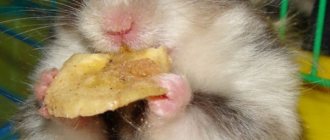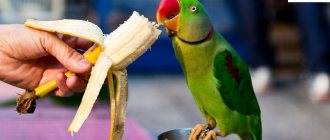Bananas and pet rats don't seem to mix. But the fact is that rats love to pop bananas or banana chips into their mouths if they find them nearby. What to do if your pet starts eating banana? Is it worth taking the fruit away from a rodent? Is this fruit safe for rats or can feeding bananas lead to dangerous consequences?
Bananas are a very common delicacy among people. This fruit is considered healthy due to its high percentage of vitamins and minerals. But not all human food is suitable for feeding rats. Let's find out whether this healthy fruit can be given to rats.
Do rats like bananas?
Rats are naturally drawn to foods high in fat or sugar because it gives them the energy they need to live. Because bananas are relatively high in sugar, most rats love to eat them. However, rats have their own likes and dislikes, so it is possible that one of your rats will not be very interested in this particular fruit. To find out if your rat likes bananas, simply offer him a small piece. If they like the fruit, they will eat it, and if they don't like it, they will simply ignore it. If they ignore the fruit in question, make sure you remove the banana from its cage before it starts to rot.
If your rat doesn't like banana, don't worry, there are plenty of other fruits and vegetables they can safely eat, so there's no reason to force them to eat bananas.
Taste preferences of wild rats
Despite all the promiscuity of the creatures we are considering, there are some foods that rats like more than others. Thus, if there is a choice between wheat and wholemeal flour, preference will be given to the latter
Although if the grain is thoroughly wet or mixed with odorless vegetable oil, attention will be divided equally between both “dishes”
Sweets are what rats (both tame and free) eat with special pleasure
Moreover, it doesn’t matter how nutritious the food is, sweetened with saccharin will do. So in this case, it is not the caloric content (and, accordingly, the survival factor), but the taste sensation that is important
The following fact is noteworthy: what a white rat eats can be categorically rejected by its wild relatives. For example, it is well established that laboratory albinos prefer food with the addition of anise and butyric acid, while ordinary rats diligently avoid it. Moreover, if experimental cubs are fed only food with such additives, and then offered a treat without them, they will not hesitate to change the imposed diet. Scientists believe that the attachment of white rats to these “flavors” is genetic, innate.
The benefits of bananas for rodents
Bananas also contain many vitamins, minerals and antioxidants. They are especially rich in potassium, which is an electrolyte that helps the rat's nerve endings function and contract muscles. They are also a good source of vitamin B6, which helps the body use and store energy from proteins and carbohydrates.
- Vitamin C:
Helps in reducing the risk of scurvy. This is a disease that affects the skin of rats. - Magnesium:
Promotes muscle, nervous system, heart and immune function. - Potassium
: Plays a major role in heart function and also strengthens muscles and digestion. - Pectin
: helps the rat get rid of toxins and everything unnecessary in the body. It heals the intestines and suppresses antiperistalsis (acid reflux) and prevents the risk of stomach ulcers and stomach cancer. - Tryptophan:
this component ends up in a product called serotonin, which is a major contributor to improving mood and making a person happy.
So yes, let your pet rat chew on that banana, but be careful with some of the small details.
Vegetables
Some vegetables should not be fed to pet rats.
Cabbage (white, red, cauliflower, Brussels sprouts, kohlrabi) causes severe gas formation in the intestines of rodents, and is therefore prohibited for these pets.
Radishes, radishes, and turnips also increase gas formation and should not be fed to rats.
Beans, beans, peas, chickpeas, lentils, soybeans and soy products increase gas formation. And dried peas, mung beans and chickpeas are allowed in limited quantities if the pet does not have problems with the digestive system.
Artichokes should not be given raw.
Raw eggplants contain solanine. If you want to treat your pet to such a vegetable, then first peel it and heat treat it.
Potatoes cannot be eaten raw - they contain a large amount of starch, and green potatoes - contain solanine, just like sprouts and tops. You can occasionally offer your pet a small piece of boiled potato.
Beets should be given to rodents in very limited quantities and not often.
How much banana should I give to rats?
Only about 20% of your rat's daily diet should consist of fruits and vegetables. However, you should make sure that they eat a variety of fruits and vegetables, not just bananas. The reason for this is that fruits and vegetables have different nutritional values. By giving your rat a wide variety of different fresh foods, you can be sure that he won't miss out on anything.
You can give them thin slices or even mash bananas to help them chew. Rats also like dried banana, so try giving your rodent similar snacks.
With that said, it is recommended that you feed your rat no more than a few slices of banana per week.
At what point in a rodent's life is this product allowed?
Veterinarians advise owners to begin introducing this product into the animal’s menu starting from the 4th month of the pet’s life. This is due to the rat’s body’s needs for special cereals and mixtures that are suitable for rodents aged 0–3 months. Only after this period of life, veterinarians are allowed to treat the animal with treats, but only in small portions, gradually increasing the amount of product to 15 grams per week and 2.5 grams per day.
Can rats eat banana peels?
Now that you know that bananas are safe for rats, you may be wondering if they can eat the peel. The point is that they can indeed eat the peel, but you have to be careful about it.
Pesticides can accumulate on the skin of bananas, especially if they are inorganic. The best way to get rid of pesticides on fruit is to soak it in a mixture of baking soda and water, then rinse it with cold water. However, keep in mind that it is very likely that your rats will ignore the peel in favor of the tastier banana pulp.
You can also feed your rat only the banana pulp and discard the peel. This is what most rat owners do. This way, you won't have to worry about washing the banana because the pesticides are only on the peel, not the flesh of the fruit.
What can you feed decorative rats: at home
The nutrition of a decorative rat should be comprehensive. The rat is not picky enough about food and will not determine what is harmful for it and what its body needs. But the owner can do this by preparing a correct and balanced diet for the pet.
No matter what a rat eats, the animal should always have access to clean and fresh water. It is advisable that the drinking bowl be closed, so the rodent will not be able to clog the water. The water should be changed at least once every 2-3 days.
Basic food
Cereal food is the main food for the rat, the rest is extremely important feeding. Choosing cereal food is not as easy as it seems at first glance. Some food manufacturers add dye to the food to make it look nice, but this should be discarded immediately. It would be best to consult with a veterinarian who specializes in rats (ratologist) to help you choose food. Rat food often has two opposing problems - either it contains an excess of ingredients that are rich in nutritional value and tasty for the rat, because of which it quickly gets fat, or the food is poor in these ingredients. Experienced rat owners prefer to mix two types of such food.
Greenery
As for greens, rats can eat parsley leaves, dill, basil, onions, mint, cilantro, but they should avoid any indoor plants.
Tree branches and leaves of small plants should be collected away from the city and roads and must be processed before giving to your pet. You can give branches of apple, pear, quince, serviceberry, currant, hazel, linden, rowan (also chokeberry), oak, willow, birch, and aspen. Plants include chamomile, dandelion leaves and flowers, clover, plantain, fireweed.
Everything collected on the street must be washed under running water, the branches must be scalded with boiling water.
Dairy and fermented milk products
You can safely treat your rat to yoghurt, kefir, fermented baked milk and cottage cheese, of course, if the product contains no dyes, salt or sugar. But you shouldn’t give cream, sour cream and cheese. You can treat them rarely as an exception, but these products cannot be used as top dressing due to their high fat content. Giving milk is not recommended due to frequent intolerance to this product in rats.
Animal products
Sausages, smoked meats, lard, all this should not be given to rats due to the high content of fat, salt and spices.
Decorative rats can eat meat and fish, but when serving, remember that the product must be boiled without salt and spices, and also be low-fat. The fat layer and skin must be removed from the meat; pork should not be given in any form. Honey contains a lot of sugar, which is why it should not be given to your pet. It is not recommended to feed boiled eggs frequently, but once a week or two is possible, given that the yolk of the egg is too dry for a rat and needs to be soaked.
What rats shouldn't eat
Decorative rats will eat everything that the owner offers them, but the consequences can be disastrous. First of all, you need to remember four properties of human-prepared foods that should not be given to rats:
- Fat;
- Salty;
- Sweet;
- Roast;
- Smoked;
- Fresh flour products.
This short list covers many products at once, chocolate, candy, sweet drinks, sausages, ham, cheese, sausage and much more. But besides such obviously harmful products, danger lies even in vegetables and herbs. So rats should not eat legumes, radishes, radishes, turnips and cabbage (red, Brussels sprouts, cauliflower and cabbage), these products cause gas formation, which is fatal to rats. Artichokes and eggplants should not be given only raw, also with potatoes, but boiled potatoes should be given as rarely as possible. Flour products can be given only without salt in the composition and only in dried form. Nuts are too high in fat to be given to rats frequently or in large quantities. Nuts are also found in many foods, so additional servings should be reasonably limited.
Tips and tricks
So now you know that you can safely feed bananas to your pet rat. To sum it up, here are the 5 most important things you need to know before feeding bananas to your pet rat:
- Bananas are a treat, not a staple in their diet
. In small quantities, bananas can be a healthy addition to your rat's diet, but you must be careful not to overdo it. If you overdo it, it can lead to nutritional imbalance. Make sure their diet consists of about 80% kibble and 20% fresh, organic foods (which may include bananas, but should also contain other fresh plant foods). - Enter slowly.
When you first introduce a new food to your rat's diet, it is recommended to start slowly. This will allow the rat's digestive system to become accustomed to the new food. - If you give a banana with the peel, be sure to wash it thoroughly
. The peel is not toxic to rats, but you must rinse it thoroughly to remove any pesticides. - Make sure the banana is ripe
. Do not feed your rat unripe bananas, unripe (green) ones can harm your rat's digestive tract and should be avoided. - If your rat doesn't like bananas, try another fruit.
Not all rats like the same things. Most rats like bananas, but if yours doesn't, you can simply try feeding them a different fruit.
So overall, bananas are a healthy treat for rats as long as you give them in moderation. A small piece of banana as an occasional treat is fine, but don't overdo it. High sugar in large quantities is harmful to rats and can lead to weight gain. Don't replace your rat's regular diet, ideally 80% kibble and 20% fresh fruits and vegetables, with too many bananas.
Criterias of choice
If you still want to treat your little rodent with a treat, you need to understand the right choice of fruit.
The banana should not contain any green coloring, otherwise you will feed your pet solid starch. There should be small black spots on it, which means the fruit is ripe. You can also determine ripeness by smell. A yellow banana will have no odor, but the aroma of the spotted yellowish fruit will not let you pass by.
Remember, the main diet of rats: cereals, grains, dairy products and lean meat. Banana is a fruit that provides vitamins to animals. Protein is necessary for full functioning and health. It supports immunity and develops bones and muscle tissue.
Knowing all the subtleties in choosing and consuming bananas, you can not only not harm the little rodent’s body, but also please him with a pleasant treat from which he will receive the necessary vitamins.
Great article 9
Is Ulan-Ude in danger of a rat invasion?
After a series of attacks by stray dogs on people in the capital of Buryatia, their number has decreased significantly. However, according to city residents, the fight against stray dogs gives rise to another problem - an increase in the rat population. Is this true or not? We turned our question to specialists from the Republican Center for Hygiene and Epidemiology.
Dangerous neighbors
Currently, at least 64 species of these animals are found in the world. Rats eat almost any food. In search of food and new nesting sites, they can travel up to 20 kilometers, and swim all 30 kilometers. Due to the anatomical feature, rodents easily penetrate through cracks and holes four times smaller than their own body size. Possessing constantly growing and strong teeth, rats are able to gnaw holes and passages even in brick and concrete monolithic walls.
What do rodents like?
Biologists and professional deratizers (pest extermination specialists) agree that mice are more often “led” to delicacies of plant origin, while rats love animal products. But when a rodent has been hungry for a long time, it will eat whatever it finds. That is why at first it is difficult to determine who is in the house. In view of what has been described, employees of non-food industry enterprises resort to a trick - they use poisoned grain to destroy parasites. It’s cheap and works 100%, because pests have no other food.
Mice
Based on the above, the best mouse baits are:
- fresh baked goods - a fragrant wheat bun, muffin, gingerbread or a piece of soft white bread will attract the pest almost instantly;
- seeds - in the wild, mice eat grains and willingly feast on them in our homes;
- nut – as appetizing as grains;
- a slice of apple, pear, plum or peach - familiar fruits with a bright smell often become food for mice in the wild;
- peanut butter - nut paste has a pronounced aroma and smells fragrant for many meters.
Rats
Rats are practically omnivorous. They can be caught using any delicacy, but we recommend:
- lard is a product with a bright, spicy aroma that attracts rodents like a magnet;
- sausage - only high-quality sausage products will do; rats often refuse cheap ones, stuffed with chemicals;
- fresh meat - the specific smell that various parts of a chicken or pig carcass emit attracts pests;
- minced meat is an almost ideal bait for rats, better with the addition of onions;
- smoked fish is a very flavorful option that can catch the maximum number of rodents;
- vegetable oil – “fragrant” unrefined sunflower oil can be used in combination with a piece of bread.
Feeding rats video
Other similar posts:
Sea kale is rich in iodine, just like human rats also need this element.
It is best to purchase dry seaweed at a pharmacy and add it to your main feed. A rodent may have problems with the thyroid gland if its diet lacks iodine. Additionally, you can use mineral stone with algae and seafood in your diet.
You can buy seaweed in the store. It is good to rinse off the brine in several waters and offer it to the animal. The rats definitely won't eat much. We remove the remains from the cage.
It is enough to give seaweed once a week. The dry one is pre-soaked in water and offered to the animal. Its taste is not the most delicious, so you can add it to cottage cheese, yogurt or baby food.
Remember, this is the same as vitamins for humans. It's not worth giving a lot. Dry seaweed is taken on the tip of a knife (1/6 tsp) and diluted in 1-2 drops of water.
If the animal does not want to eat, do not force it. Suggest at another time. Can be stored in the refrigerator.
Great article 4
Features of rat nutrition
Coming up with a list of what rats eat is almost impossible because they eat everything. The only exceptions are absolutely inedible things, although even wires and polyethylene can be chewed and partially swallowed. However, for all their indiscriminateness, rats treat food in the wild quite reasonably. In the wild, they never overeat, so they do not become obese. If a rat is lucky enough to get a high-calorie piece, it eats less food. If what rats eat is low in nutrition, the amount consumed increases accordingly. If there is a lack of some minerals or vitamins in their body, these rodents look for foods with a high content of the necessary substance.
It should be noted that rats (domestic or wild - it makes no difference) eat all the time. If you forget to feed your pet for at least two days, it will die. Therefore, in the wild, animals are constantly in search of food, and, if possible, they create reserves.











